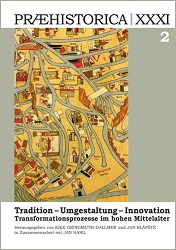Siedlungsgeschichtliche Forschungen in den nördlichen deutschen Mittelgebirgsregionen
Settlement Studies on the Northern Highland Regions in Central Germany
Author(s): Hans-Georg StephanSubject(s): Archaeology, Agriculture, Economic history, Social history, Middle Ages, Social development, Economic development
Published by: Univerzita Karlova v Praze, Nakladatelství Karolinum
Keywords: Germany; northern Germany; middle ages; archaeology; history; cultural landscape; settlements; villages; deserted villages; villages; towns; settlement history; cultural history; oeconomic history;
Summary/Abstract: The Northern German hilly landscapes and Hessen do belong to the areas with the highest concentrations of deserted medieval villages and a remarkable richness of various relicts of the historical cultural landscape in all of Europe. Quite the same is true for the favorite agricultural areas within the surroundings. The percentage of deserted villages and hamlets often is considerably higher than the total number of still surviving medieval settlements. The latter as well as the deserted villages in the area of special investigation in this article were both mostly founded in the 8th/9th centuries presumably in a rather short time within two or three generations in a period of a rapid increase of population as well as economical development and innovations. Later on there seem to have occurred two centuries of at least partial stagnations and even crisis or shrinkage of settlements, density of population and economy which caused some retreat in the settlement and cultural landscape at least in some places and regions investigated. Probably there did not happen usually migrations over wide areas outside Northwestern Europe and the coastal areas mostly threatened by the Viking raids and later in southern parts of Central Europe by the Magyars, but in general the dynamics developed in smaller regions. Generally the settlement locations in the investigated areas have been stable on the same place from an early period onwards. This stability of location may go back even to the centuries about A. D. or to the migration period in some rare cases of central places, but normally it is definitely so from the Carolingian period onwards. This seems to be a remarkable difference to usual opinions of “migrating” unstable locations of early settlements. The fact may be caused by the natural resources in hilly landscapes that differ in many ways from that in the Northern German lowlands as well as a result of the integration of Saxony in the Frankish Empire and the establishment of the special highly developed system of early medieval “Grundherrschaft”. The research about abandoned settlements and graveyards of the first millennium A. D. for its own is not sufficient at all for research. Only together with the analysis of deserted medieval villages and of persisting historical settlements it allows deeper insights and hypothetical reconstructions of the development of the cultural landscape.
Journal: Praehistorica
- Issue Year: 31/2013
- Issue No: 2
- Page Range: 43-78
- Page Count: 36
- Language: German

